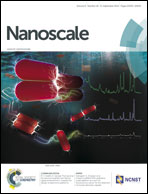Redox processes at a nanostructured interface under strong electric fields†
Abstract
Manipulation of chemistry and film growth via external electric fields is a longstanding goal in surface science. Numerous systems have been predicted to show such effects but experimental evidence is sparse. Here we demonstrate in a custom-designed UHV apparatus that the application of spatially extended, homogeneous, very high (>1 V nm−1) DC-fields not only changes the system energetics but triggers dynamic processes which become important much before static contributions appreciably modify the potential energy landscape. We take a well characterized ultrathin NiO film on a Ag(100) support as a proof-of-principle test case, and show how it gets reduced to supported Ni clusters under fields exceeding the threshold of +0.9 V nm−1. Using an effective model, we trace the observed interfacial redox process down to a dissociative electron attachment resonant mechanism. The proposed approach can be easily implemented and generally applied to a wide range of interfacial systems, thus opening new opportunities for the manipulation of film growth and reaction processes at solid surfaces under strong external fields.


 Please wait while we load your content...
Please wait while we load your content...